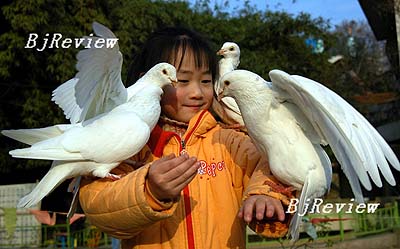|

After coming out from the Shanghai Urban Planning Exhibition Hall this summer, I took a stroll on one of the city's hot and humid afternoons. Impressed by the scale plan designed to rejuvenate already modern Shanghai, I headed off to the People's Square to reflect on the exhibition I had just seen. Strolling my way onto the square, my thoughts on space development (i.e. Nanjinglu has not really been moved but just adapted to the times) were blown away by a real-time painting happening before my eyes. I have often found that traveling around China I run into these beautiful peaceful paintings, where, as an observer, I cannot but admire how landscapes and people draw pictures together. And in Shanghai this was just another one of those moments.
I watched as a beautiful young girl in a pretty red dress was bending over feeding a group of mostly white pigeons. There she was with what appeared to be her grandmother, scattering maize kernels for the birds. The girl was in her own world as she watched the pigeons flying around her. Granny ran around fanning the air to keep the girl cool. I took out my camera to capture the moment. The girl was so caught up in the moment and in tune with her surroundings she didn't even notice me photographing her. For me this was a real-time painting and an expression of perfect harmony.
I turned to leave with this image firmly stuck in my mind. To my surprise, just 50 meters away there were three children playing with another flock of pigeons. Quite puzzled I watched as they chased after them, scaring them away. Confronted with contrasts I realized the relation between nature and humanity is more than ethical. It is not only about respecting nature's qi (vital energy), but also of understanding that as such it is a living being, with its own force.
Each person's behavior impacts on another person's actions. Admiring and cohabiting with nature therefore helps us discover our human essence.
That relationship between people and nature must happen step by step, just as the process in all kinds of relationships. Once our actions act upon the perceptions of our surroundings, our individual and social development will be aligned to nature's environment. But to do so, as has been happening in China since its opening-up, entails opening up our minds to nature. Despite the drawbacks economic development has forced onto the environment in China, these have also meant that Chinese people have taken nature's charm to their hearts.
Just a couple of weeks ago I visited the China Art Gallery (always an excellent place to get lost in thought) where a superb exhibition of the works of the Zhou Brothers was on display. Their art, embracing the elements harmony, attests to the growing relationship between heaven and earth. Beginning with their early From Heaven to Earth series back in 1980, the well-renowned Zhou Brothers clearly differentiated the foothold where heaven and earth stand. The careful oil painted lines and traces bordering men's figures signals the first step in their blending with heaven. The distinct distance between them tells of their awareness of each other's existence. While not yet engaging, heaven and earth are receptive towards each other.
Through perception people and nature gradually shape their uniqueness and interact according to each other. Hence, men give themselves to rituals to show respect to earth and heaven. The Zhou Brothers explored enchanting rituals in a 1995 canvas entitled Moon Dance. Moving our bodies-and as a Latin American I can testify-allows us to express our emotions outwardly to heaven. Yet it is not only about sharing our essence under heaven but also about sharing it among people here on earth. After all, what is heaven if not its reflected magic in nature? And what is earth if is not the ritual of men?
The practice of rituals as Confucius once said establishes one's character. Through the rules of rituals we shape our behavior and consequently the relationships between people. By connecting heaven and earth, both balance in harmony. Thus, internalizing heaven on earth becomes the driving force in the Zhou Brothers' The Heaven in Love series in 2000. In these, men' silhouettes taking over their past figures herald their harmony with heaven, where one cannot be without the other. Love therefore is witness to the process in which harmony develops socially embedded individuals.
In China, as her children and art illustrate, the enabling conditions are emerging for such a process to extend its reach not only to the hearts of the rest of her people, but also to those of the international community living in her land. As the Shanghainese little girl performed the beauty of her social role, setting an example to her peers nearby, so the fabulous art of the Zhou Brothers is just another invitation for all of us to bond in harmony.
The author is a South American living in Beijing. | 